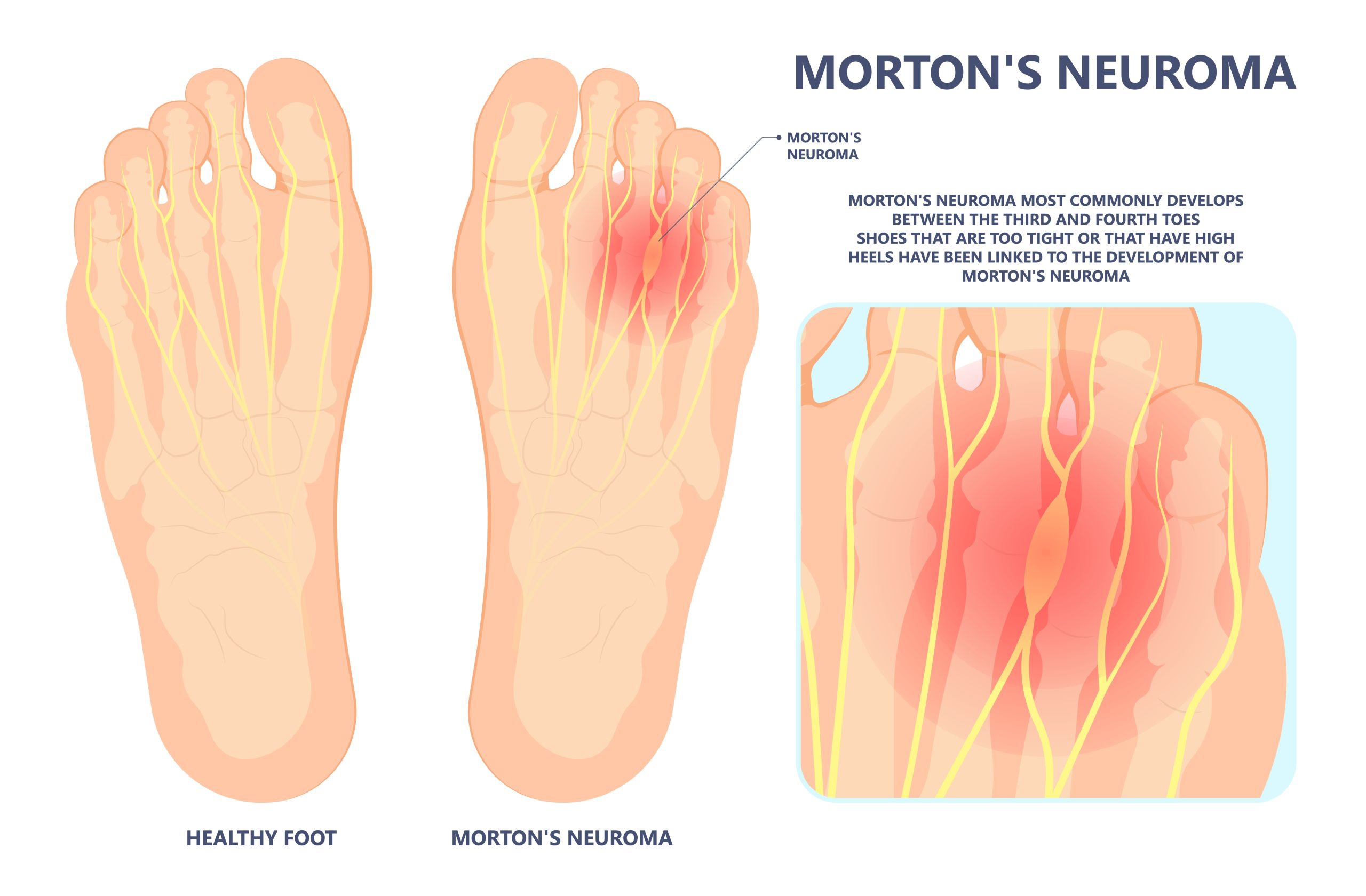Introduction to Morton’s Neuroma
Morton’s Neuroma is a painful condition that occurs when one or more of the nerves supplying sensation to the toes are squeezed and irritated over a period of time causing scarring of the nerve and in turn more persistent pain in the forefoot (often including a burning pain and feeling of numbness in the affected toes).
If left untreated, patients may eventually require Morton’s Neuroma treatment to alleviate the symptoms and prevent deterioration.
This condition causes pain in the ball of the foot that transfers to the toes, and is commonly between the third and fourth toes.
Symptoms
The main symptom of Morton’s Neuroma is pain. This is generally a shooting, stabbing or burning pain and is often felt under the foot. Patients often seek treatment for Morton’s Neuroma due to the chronic and worsening nature of this discomfort.
The pain has been likened to feeling as though there is a small stone under the foot or in the shoe.
Some people may also experience a tingling or numbness in the foot and the affected area may feel tender to press. There may also be slight swelling of the affected area
The symptoms may be worse when you move your foot or wear tight or high-heeled shoes. It often gets worse over time.

Causes of Morton’s Neuroma
There are many causes of Morton’s Neuroma including:
- Being overweight putting extra stress on the feet
- Overuse, for example jobs that involve a lot of standing on hard surfaces, or lots of walking
- Unsupportive, poorly fitting shoes
- An enlarged nerve in the ball of the foot (Morton’s neuroma)
- It can be more common in conditions such as rheumatoid arthritis
- Altered foot function
- Clawed or hammer toes can increase pressure on the ball of the foot. Explore more about how altered biomechanics and conditions like toe deformities can impact foot health.
Diagnosis for Morton’s Neuroma


Only when a diagnosis has been made can Morton’s Neuroma treatment be initiated.
Morton’s Neuroma Treatment
The method of Morton’s Neuroma treatment varies as per the symptoms and severity of the individual’s case.
Treatment for Morton’s Neuroma depends on longevity and severity of the symptoms. Initial treatment of Morton’s Neuroma is usually conservative, non-surgical and simple.
The point of these methods is to relieve pain and prevent from recurrence.
- Changing your footwear
- Orthotics
- Corticosteroid injections
If conservative Morton’s Neuroma treatments haven’t helped, further options may be considered;
Decompression surgery
In some cases, surgeons can relieve the pressure on the nerve by cutting nearby structures, such as the ligament that binds together some of the bones in the front of the foot. This surgery for Morton’s Neuroma can be highly effective.
Removal of the nerve
Surgical removal of the growth may be necessary if other treatments fail to provide pain relief. Although this type of Morton’s Neuroma surgery is usually successful, the procedure can result in permanent numbness in the affected toes.
Radiofrequency ablation
Radiofrequency ablation uses an electric current to heat up a small area of nerve tissue to stop it from sending pain signals. It can provide lasting relief for people with chronic pain, especially those not suited for a extensive Morton’s Neuroma operation.
Calf release
Calf muscle release is a surgical procedure involving the surgical release of the calf muscle by making an incision in the back of the leg to gain access to the calf muscle which is then cut to release tension in the calf muscle.
Learn more about our surgical expertise on the foot surgery page.
Book A Consultation
If you’re experiencing symptoms of Morton’s Neuroma and looking for expert care in London, our orthopaedic consultants offer world-class Morton’s Neuroma treatment tailored to your needs.
Fill out the contact form below or get in touch with us here to book a consultation.




